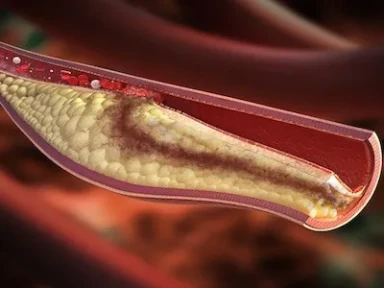Impact of anemia on long-term clinical outcomes in venous thromboembolism: Findings from Garfield-VTE registry
.png/jcr:content/impact-of-anemia%20(2).png)
Key Takeaway
Garfield-VTE study results showed that patients with VTE and concomitant anemia had a higher risk of adverse clinical outcomes vs those without anemia.
Baseline anemia is a prominent predictor of the risk of major bleeding and all-cause mortality but does not influence the risk of recurrent VTE.*
Patients with anemia were more likely to receive parenteral anticoagulants and VKAs and less likely to receive DOACs.†
Why This Matters
GARFIELD-VTE registry study analyzed real-world population of VTE patients, thus allowing an understanding of current outcomes and treatment protocols in a clinical setting.
This study demonstrated the need for appropriate therapeutic management strategies to reduce the risk of major bleeding and mortality for patients with VTE and concomitant anemia.
Study Design
Garfield-VTE: Global, Prospective, Non-interventional Registry (10,685 Adult Patients With Vte [415 Sites Across 28 Countries Worldwide])
Key Inclusion Criteria
Objective diagnosis of VTE within ± 30 days of entry into the registry
Key Exclusion Criteria
Long-term follow-up was not planned; Hb values were not measured; or Hb values were measured outside the 30-day window of entry into the registry
Primary clinical outcomes: All-cause mortality, recurrent VTE, and major bleeding‡ in patients with and without anemia over 24-months from VTE diagnosis
Secondary clinical outcomes: Non-major bleeding§, MI/ACS, non-hemorrhagic stroke/TIA, and cancer
Key Results
72.1 % patients (7,698/10,679) diagnosed with VTE were eligible for analysis
- Patients with Anemia: n = 2,771
- (median age = 62.6 years; DVT events = 61.1%; PE ± DVT events = 38.9%)
- Patients without Anemia: n = 4,927
- (median age = 58.9 years; DVT events = 55.9%; PE ± DVT events = 44.0%)
VTE Risk Factors (Patients with vs without Anemia):
-
Active cancer:
20.1% vs 5.6% -
History of cancer:
22.4% vs 9.2% -
CHF: 4.2 vs 2.5%
-
Chronic immobilization:
8.2% vs 4.0% -
Renal insufficiency:
6.6% vs 2.4% -
Hospitalization:
22.0% vs 6.8% -
Surgery: 19.2% vs 8.2%
-
Previous VTE:
10.0% vs 17.9%
Primary Clinical Outcomes (Patients with vs without Anemia)¶:
-
All-cause mortality: HR = 1.84
(95% CI: 1.56–2.18; P <0.0001) -
Major bleeding: HR = 2.83
(95% CI: 2.14–3.75; P <0.0001) -
Recurrent VTE: HR = 0.96
(95% CI: 0.79–1.16; P = 0.6440)
Secondary Clinical Outcomes (Patients with vs without Anemia)¶:
-
Any bleeds: HR = 1.41
(95% CI: 1.23–1.62; P <0.0001) -
MI/ACS: HR = 2.01
(95% CI: 1.21–3.34; P <0.0092) -
Stroke/TIA: HR = 1.56
(95% CI: 1.01–2.41; P = 0.0489) -
Cancer: HR = 1.07
(95% CI: 0.83–1.38; P = 0.6150)
Patients who remained on anticoagulant treatment at 24-months (with vs without anemia): 40.0% vs 51.2%
Key Limitations
- Data collection was non-randomized
- Intention-to-treat concept was used; however, this approach did not consider treatment duration/discontinuation or fluctuating Hb values after initial assessment at baseline
- Hb values were only available for 7,698/10,679 patients
* Patients with severe anemia vs those with mild/moderate anemia had higher risk of all-cause mortality (HR = 1.42 [95% CI: 1.17–1.72]; P = 0.0004) and major bleeding (HR = 1.84 [95% CI: 1.33–2.55]; P = 0.0003).
† Patients with vs without anemia (at baseline): Parenteral therapy alone = 26.6% vs 11.7%; VKA alone = 5.7% vs 5.0%; VKA + parenteral therapy = 25.6% vs 28.1%; DOACs alone = 24.5% vs 32.8%; DOAC + parenteral therapy = 14.0% vs 20.7%.
‡Clinically overt bleeding associated with a critical site, a fall in Hb of 2 g/dL, transfusion of 2 or more units of red blood cells, hemorrhagic stroke, or fatal outcome.
§Any bleeding that did not meet the major bleeding criteria.
¶At 24 months, after adjustment for cancer status, age, ethnicity, and BMI (adjusted HR for mortality with 95% CIs for 24-month outcomes after VTE diagnosis between patients with anemia and or with no-anemia [reference group]).
ACS, Acute coronary syndrome; CHF, Chronic heart failure; CI, Confidence interval; DOACs, Direct oral anticoagulants; DVT, Deep vein thrombosis; GARFIELD, Global Anticoagulant Registry in the FIELD; Hb, Hemoglobin; HR, Hazard ratio; MI, Myocardial infarction; PE, Pulmonary embolism; TIA, Transient ischemic attack; VKAs, Vitamin K antagonists; VTE, Venous thromboembolism.
- Goto S, Turpie AGG, Farjat AE, Weitz JI, Haas S, Ageno W, et al. The influence of anemia on clinical outcomes in venous thromboembolism: Results from GARFIELD-VTE. Thromb Res. 2021;203:155–162. doi: 10.1016/ j.thromres.2021.05.007. PMID: 34023735.


